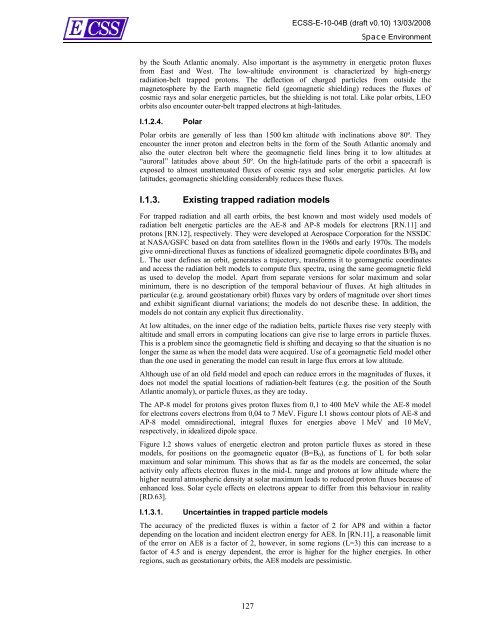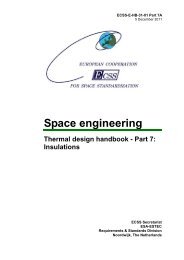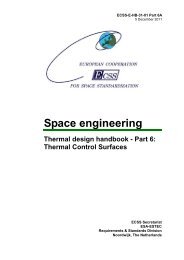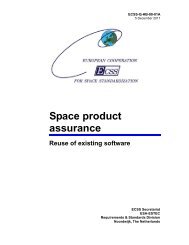ECSS E 10-04 v0.10 - European Cooperation on Space Standardization ...
ECSS E 10-04 v0.10 - European Cooperation on Space Standardization ...
ECSS E 10-04 v0.10 - European Cooperation on Space Standardization ...
You also want an ePaper? Increase the reach of your titles
YUMPU automatically turns print PDFs into web optimized ePapers that Google loves.
127<br />
<str<strong>on</strong>g>ECSS</str<strong>on</strong>g>-E-<str<strong>on</strong>g>10</str<strong>on</strong>g>-<str<strong>on</strong>g>04</str<strong>on</strong>g>B (draft v0.<str<strong>on</strong>g>10</str<strong>on</strong>g>) 13/03/2008<br />
<strong>Space</strong> Envir<strong>on</strong>ment<br />
by the South Atlantic anomaly. Also important is the asymmetry in energetic prot<strong>on</strong> fluxes<br />
from East and West. The low-altitude envir<strong>on</strong>ment is characterized by high-energy<br />
radiati<strong>on</strong>-belt trapped prot<strong>on</strong>s. The deflecti<strong>on</strong> of charged particles from outside the<br />
magnetosphere by the Earth magnetic field (geomagnetic shielding) reduces the fluxes of<br />
cosmic rays and solar energetic particles, but the shielding is not total. Like polar orbits, LEO<br />
orbits also encounter outer-belt trapped electr<strong>on</strong>s at high-latitudes.<br />
I.1.2.4. Polar<br />
Polar orbits are generally of less than 1500 km altitude with inclinati<strong>on</strong>s above 80º. They<br />
encounter the inner prot<strong>on</strong> and electr<strong>on</strong> belts in the form of the South Atlantic anomaly and<br />
also the outer electr<strong>on</strong> belt where the geomagnetic field lines bring it to low altitudes at<br />
“auroral” latitudes above about 50º. On the high-latitude parts of the orbit a spacecraft is<br />
exposed to almost unattenuated fluxes of cosmic rays and solar energetic particles. At low<br />
latitudes, geomagnetic shielding c<strong>on</strong>siderably reduces these fluxes.<br />
I.1.3. Existing trapped radiati<strong>on</strong> models<br />
For trapped radiati<strong>on</strong> and all earth orbits, the best known and most widely used models of<br />
radiati<strong>on</strong> belt energetic particles are the AE-8 and AP-8 models for electr<strong>on</strong>s [RN.11] and<br />
prot<strong>on</strong>s [RN.12], respectively. They were developed at Aerospace Corporati<strong>on</strong> for the NSSDC<br />
at NASA/GSFC based <strong>on</strong> data from satellites flown in the 1960s and early 1970s. The models<br />
give omni-directi<strong>on</strong>al fluxes as functi<strong>on</strong>s of idealized geomagnetic dipole coordinates B/B0 and<br />
L. The user defines an orbit, generates a trajectory, transforms it to geomagnetic coordinates<br />
and access the radiati<strong>on</strong> belt models to compute flux spectra, using the same geomagnetic field<br />
as used to develop the model. Apart from separate versi<strong>on</strong>s for solar maximum and solar<br />
minimum, there is no descripti<strong>on</strong> of the temporal behaviour of fluxes. At high altitudes in<br />
particular (e.g. around geostati<strong>on</strong>ary orbit) fluxes vary by orders of magnitude over short times<br />
and exhibit significant diurnal variati<strong>on</strong>s; the models do not describe these. In additi<strong>on</strong>, the<br />
models do not c<strong>on</strong>tain any explicit flux directi<strong>on</strong>ality.<br />
At low altitudes, <strong>on</strong> the inner edge of the radiati<strong>on</strong> belts, particle fluxes rise very steeply with<br />
altitude and small errors in computing locati<strong>on</strong>s can give rise to large errors in particle fluxes.<br />
This is a problem since the geomagnetic field is shifting and decaying so that the situati<strong>on</strong> is no<br />
l<strong>on</strong>ger the same as when the model data were acquired. Use of a geomagnetic field model other<br />
than the <strong>on</strong>e used in generating the model can result in large flux errors at low altitude.<br />
Although use of an old field model and epoch can reduce errors in the magnitudes of fluxes, it<br />
does not model the spatial locati<strong>on</strong>s of radiati<strong>on</strong>-belt features (e.g. the positi<strong>on</strong> of the South<br />
Atlantic anomaly), or particle fluxes, as they are today.<br />
The AP-8 model for prot<strong>on</strong>s gives prot<strong>on</strong> fluxes from 0,1 to 400 MeV while the AE-8 model<br />
for electr<strong>on</strong>s covers electr<strong>on</strong>s from 0,<str<strong>on</strong>g>04</str<strong>on</strong>g> to 7 MeV. Figure I.1 shows c<strong>on</strong>tour plots of AE-8 and<br />
AP-8 model omnidirecti<strong>on</strong>al, integral fluxes for energies above 1 MeV and <str<strong>on</strong>g>10</str<strong>on</strong>g> MeV,<br />
respectively, in idealized dipole space.<br />
Figure I.2 shows values of energetic electr<strong>on</strong> and prot<strong>on</strong> particle fluxes as stored in these<br />
models, for positi<strong>on</strong>s <strong>on</strong> the geomagnetic equator (B=B0), as functi<strong>on</strong>s of L for both solar<br />
maximum and solar minimum. This shows that as far as the models are c<strong>on</strong>cerned, the solar<br />
activity <strong>on</strong>ly affects electr<strong>on</strong> fluxes in the mid-L range and prot<strong>on</strong>s at low altitude where the<br />
higher neutral atmospheric density at solar maximum leads to reduced prot<strong>on</strong> fluxes because of<br />
enhanced loss. Solar cycle effects <strong>on</strong> electr<strong>on</strong>s appear to differ from this behaviour in reality<br />
[RD.63].<br />
I.1.3.1. Uncertainties in trapped particle models<br />
The accuracy of the predicted fluxes is within a factor of 2 for AP8 and within a factor<br />
depending <strong>on</strong> the locati<strong>on</strong> and incident electr<strong>on</strong> energy for AE8. In [RN.11], a reas<strong>on</strong>able limit<br />
of the error <strong>on</strong> AE8 is a factor of 2, however, in some regi<strong>on</strong>s (L=3) this can increase to a<br />
factor of 4.5 and is energy dependent, the error is higher for the higher energies. In other<br />
regi<strong>on</strong>s, such as geostati<strong>on</strong>ary orbits, the AE8 models are pessimistic.






